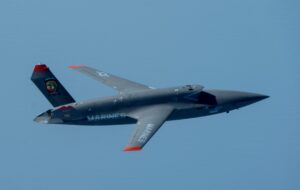The Marine Corps recently conducted the first flight test of the Kratos Defense and Security Solutions’ [KTOS] XQ-58A Valkyrie autonomous low-cost unmanned air vehicle in support of a program that would have such an aircraft act as a cooperative combatant.
The service in a statement said the tests “marks a key milestone in the Marine Corps’ Penetrating Affordable Autonomous Collaborative Killer – Portfolio (PAACK-P) program. Future test flights inform Marine Corps XQ-58A Valkyrie requirements for the Marine Air-Ground Task Force Unmanned Aerial System Expeditionary (MUX) Tactical Aircraft (TACAIR). “

The Marine Corps conducted this Valkyrie test at Eglin Air Force Base, Florida on Oct. 3. The service reported the “aircraft performed as expected.”
The service has so far planned six total test flights with objectives including evaluating its ability to support intelligence, surveillance and reconnaissance (ISR) missions; effectiveness of using autonomous electronic support to crewed platforms; the potential for AI platforms to augment combat air patrols; and “continuing to mature other manned-unmanned teaming (MUM-T) capability objectives.”
In January, the Navy ordered two Valkyrie aircraft from Kratos for the Marine Corps, including sensor and weapon system payloads “to accomplish the penetrating affordable autonomous collaborative killer – portfolio objectives,” the contract notice said. In this program the service may use the Valkyries as motherships for smaller drones as well as perform electronic warfare and intelligence gathering (Defense Daily, Jan. 5).
The Marine Corps received the first XQ-58A on March 14 with the specific goal to support platform prototyping and integration efforts for PAACK-P.
The Air Force Research Laboratory has been testing Valkyrie since 2020 as an example and option of what drones in its Skyborg Vanguard program could look like. The XQ-58A is also in contention as an option as the Air Force’s Collaborative Combat Aircraft (CCA) as part of the service’s Next Generation Air Dominance (NGAD) effort.
In August, the Air Force conducted an artificial intelligence-navigated sortie to help feed the CCA effort, which looks to ultimately have the Lockheed Martin [LMT] F-35A and manned NGAD aircraft be able to launch a CCA. That test also launched from Eglin (Defense Daily, Aug. 3).
Last month, a Kratos official told Defense Daily each XQ-58 that comes off the production line can fly autonomously, using way points, and make decisions. It also is tailored to each customer without a baseline mission set (Defense Daily, Sept. 14).
“Testing the XQ-58 Valkyrie determines requirements for a highly autonomous, low-cost tactical UAS that compliments the need for agile, expeditionary and lethal capabilities in support of both the Marine Corps’ stand-in force operations in austere environments and the Joint Force,” Lt. Col. Donald Kelly, Headquarters Marine Corps Aviation Cunningham Group and Advanced Development Team, said in a statement.
He said this is an example of how the service is always looking to modernize and enhance capabilities.
“This XQ-58A test flight and the data collected today not only help to inform future requirements for the Marine Corps. It fuels continued joint innovation and experimentation opportunities and demonstrates the agility that can be achieved through partnership,” Scott Bey, a prototyping and experimentation portfolio manager at the Office of the Undersecretary of Defense for Research and Engineering (OUSD R&E), added.
The Marine Corps is partnering with OUSD R&E, the Naval Air Systems Command and Naval Air Warfare Center Aircraft Division (NAWCAD) to support ongoing research, development and evaluation efforts with these aircraft.
The service said this was also supported by the 40th Flight Test Squadron, 96th Test Wing and the NAWCAD.